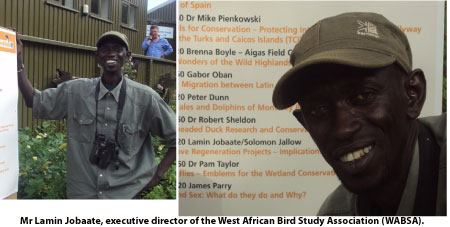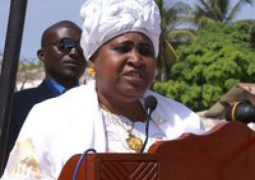
Hello and a warm welcome to another edition of Environment, your weekly column aimed at bringing environmental issues into the limelight.
This week we bring you an interview with Mr Lamin Jobaate, executive director of the West African Bird Study Association (WABSA). We spoke with him earlier this week at his offices in Abuko about his work with the association, the importance of bird conservation to the environmental and economic wellbeing of The Gambia and the recent mangrove conservation project.
WABSA was formed in 1994 by Gambian youths who were concerned about the preservation of the country’s flora and fauna. The association now works with the government to develop policies that mainstream bird study and help protect the environment.
Mr Jobaate recently returned from the UK where he attended the popular Rutland Birdfair, an annual bird watching industry event. The Birdfair has been running for the last 24 years and attracts up to 20,000 visitors from across the globe who come to promote their products and enjoy the exhibitions and lectures. Visited by industry types and wildlife enthusiasts alike, the Birdfair is also an opportunity for people to come together in the interests of supporting global bird conservation.
According to Mr Jobaate, the Birdfair is a great opportunity for The Gambia and WABSA to promote their bird watching and wildlife activities. This year, Mr Jobaate’s presentation was centered on WABSA’s involvement in mangrove planting in The Gambia and its beneficial impact on migratory birds.
WABSA is currently involved in many programs and activities aimed at restoring the mangroves to create conducive habitats for birds, including migratory birds species. The mangrove restoration programme contributes to the enrichment of the habitats of migratory birds. It provides more spawning areas for fish which migratory birds depend on for food. More water bird species were recorded in the restored areas than before the mangrove conservation project began.
This is good news for The Gambia’s wildlife and good news for the thousands of tourists who visit each year in order to go bird watching. About 550 bird species have been recorded in The Gambia, and approximately 240 species breed here. Many migratory birds visit The Gambia during the European winter. Thanks to the diversity of the bird and wildlife, ecotourism is becoming increasingly important to The Gambia’s economy.
Ecotourism originated in the late 1980s and since then there has been much debate on what it really is. However, as awareness has grown of the limited nature of resources on the planet, and attitudes towards the environment have changed, so have attitudes towards what people expect to gain or give during their travel experiences.
According to Mr Jobaate, some see ecotourism as the solution to multiple evils, others see it as a dangerous concept which can only lead to further degradation of cultures and the environment.
There are two broad dimensions in the argument for the protection of wildlife: ethical and utilitarian. In terms of ethics, some say that bringing about the extinction of species that share the planet with us, such as birds, cannot be justified. The utilitarian argument says that these species are useful to us in many ways and we therefore need to protect them.
Mr Jobaate said that birds form a beautiful part of the natural environment and most species of birds are peaceful and harmless. Economically, birds are important to countries like The Gambia as they attract a large number of tourists.
However, human beings are constantly influencing the ecosystem by using harmful pesticides to kill pests, some of which could be easily controlled biologically without using chemicals. Misuse of hazardous chemicals is harmful to birds, man and the environment. Research over the years has shown that birds are very vulnerable to chemical pesticides.
According to Mr Jobaate, some of The Gambia’s bird species are under threat, such as the touracos or ‘plantain eaters’. These are medium-to-large woodland or forest-adapted birds endemic to Africa. The predominant plumage colours of this group of birds ranges through greens, reds, purple, blues and grays. In good light there is often a waxy or silky sheen to the feathering.
Touracos, said Mr Jobaate, usually nest high in creeper covered trees and usually only build a frail and flimsy platform of twigs in which the female lays two whitish eggs which are incubated for 21-24 days. After hatching, the infant birds use claws on their wing joints to scramble to the edge of the nest and onto nearby branches.
Mr Jobaate revealed that the WABSA is currently engaged in researching local bird names, establishing bird study clubs in schools and sanctuaries, and raising awareness of bird study and its related activities.
According to Mr Jobaate, there needs to be a program of capacity building along coastal West Africa for migratory bird research, conservation and management, supported by a strong network of environmental NGOs with capacity to contribute actively to migratory bird conservation in the country and beyond.
A strong partnership with relevant stakeholders can contribute to improved conservation status of migratory birds and their habitats in West Africa through regional policy and advocacy actions.
For your comments, suggestions and contributions please contact (00220) 6361340 / 7142236 or Email: bajgambia2011@yahoo.com


